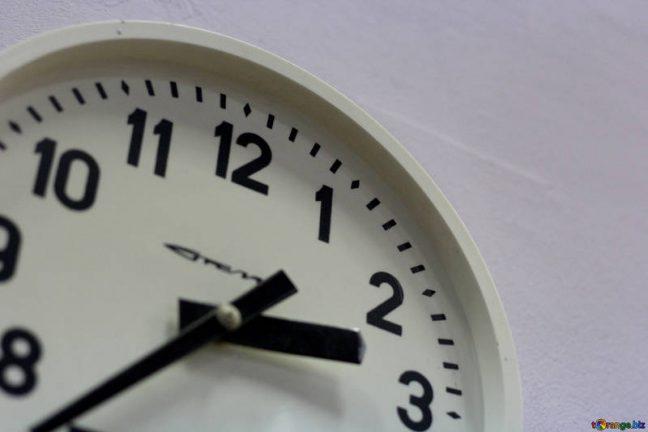A philosophy professor pondered to a packed room of observers whether time travel was possible Thursday. The answer? Maybe.
Though it is often used as a concept in TV shows, movies, science fiction books and pop culture, Peter Vranas, a University of Wisconsin philosophy professor, took the topic seriously. He wondered how time travel should be defined and what would have to be true for it to exist.
Vranas said there are two distinct types of time travel — multiple universe time travel and single universe time travel. In multiple universe time travel, the time traveler would be able to access multiple universes. In single universe time travel, only one universe can be accessed.
The multiple universe theory poses major problems for the time traveler, though. It is possible to accidentally end up in the middle of a black hole instead of the 1930s if the time traveler cannot completely control where they are going, Vranas said.
If a traveler does not wind up in a black hole, the multi-dimensional time traveler stamps a “one-way ticket.” The traveler can never re-enter their unaltered universe because the past cannot be changed.
Under the umbrella of single universe time travel, however, the process is much different. The time traveler could have three options: by time jump, by time slide or through a wormhole.
Marty McFly in the popular 1985 movie “Back to the Future” utilized a “time jump.” McFly accelerates in his DeLorean time machine – also known as a modified sports car – and is transported to 1955.
The main issue Vranas has seen others raise with this form of time travel is that there is no current widely accepted explanation as to how it fits into the law of conservation of mass and energy.
“At disappearance, the time traveler’s body is converted into energy,” Vranas said as a tentative explanation. “At reappearance, energy is converted into a qualitatively identical body.”
A time slide is the other end of the spectrum. In a time jump, the traveler does not perceive any time spent on the journey. In a time slide, the traveler sees history flash before their eyes in a faster-than-average rate, Vranas said.
An example of this can be seen in the 1960 movie “The Time Machine,” when character H.G. Wells watches 17 years of women’s fashion change on a mannequin across the street from him in the span of a minute. But this, like the other forms, has its issues.
“A traveler enters the machine at noon. Before noon, at 11:59 a.m. the machine is empty. At noon, the machine with the traveler starts moving backwards in time, through 11:59 a.m., 11:58 a.m., etcetera. So at 11:59 a.m., the machine is both empty and occupied,” Vranas said. “Contradiction!”
Vranas cited the possibility of a time machine that moves slightly in space as it moves in time, which would eliminate the issue of a place being both occupied and not at the same time.
The third option: wormholes.
A wormhole tunnel – think “Dr. Who” or “Contact” – can be used as a time machine by forming a shortcut between two far away things.
But Vranas said a time traveler will have to contend with the Twin Paradox. The paradox states that if there is a set of identical twins, and one goes to space and the other stays on earth, the one who went to space will have aged less in the same number of years, according to Vranas.
Consider a wormhole with one mouth in Boston and the other mouth in Detroit, Vranas said. The trip through the wormhole takes two minutes. Then, put the Boston mouth on a spaceship, take it on a space trip and return it to Boston.
Then, according to the Twin Paradox, the Boston mouth had aged less than its surroundings that stayed in Boston. While the rest of Boston is 12 p.m., it’s 8 a.m. inside the Boston mouth.
The wormhole functions like a time machine. Start your trip at 12 p.m. by entering the Boston mouth. Inside the Boston mouth, it’s 8 a.m. Go through the wormhole in 2 minutes and exit in Detroit at 8:02 a.m. Catch a 9 a.m. flight back to Boston, arriving at 11 a.m. – before the trip even started.
Though this is the only form of time travel taken seriously by physicists, Vranas couldn’t offer a solution to this problem, though this is the only form of time travel taken seriously by physicists.
A paradox that plagues all of time travel is the Retro-suicide Paradox, Vranas said, where the time traveler goes back in time to kill their younger self. But, paradoxically, the time traveler would have failed because one must still be alive in order to go back in time to kill oneself.
In response to this paradox, Vranas proposed two types of time: uncontrollable time and controllable time.
The Retro-suicide Paradox does not apply to uncontrollable time travel because the traveler cannot control where they are going, and thus they cannot decide to go back in time to kill their younger self, according to Vranas. This can be applied to any action taken in the past, because of the butterfly effect, he added.
But Vranas encouraged time travel enthusiasts not to give up.
“The paradoxes of time travel do not show time travel to be impossible,” Vranas said.


